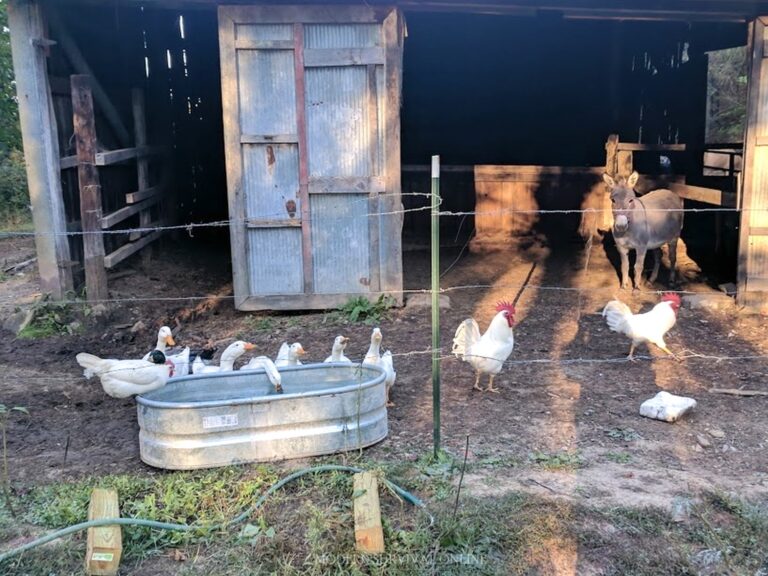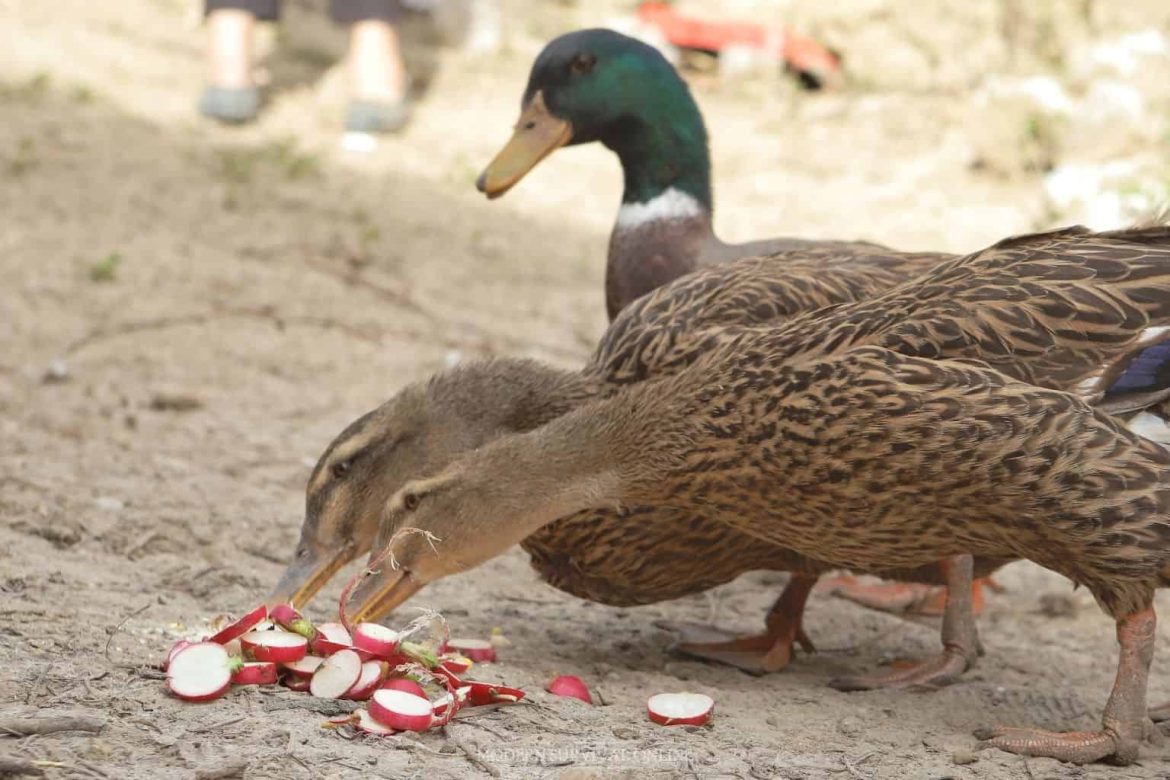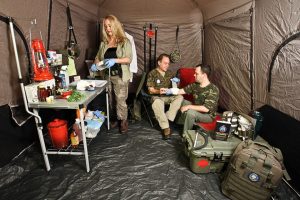Ducks are very resilient to cold. They can tolerate snow quite well because they have natural insulation in their bodies that help them keep warm. They have a thick layer of fat underneath their waterproof down feathers that helps them ward off the cold wet snow and rain.
Is this a guarantee that your ducks will do fine in winter with the same living environment you have provided for them all summer long?
No, definitely not!
For one thing, they can freeze to death if they do not have a warm shelter from the wind and the elements. They should have a fully enclosed coop with windows or ventilation openings to ensure the air they are breathing is clean and healthy.
Second, their feet do not have fat to protect them from the cold ground or snow. They can get frostbite if the ground is too cold, and they do not have a protected area with warm bedding or insulated ground on which to walk and lie down.
If they develop frostbite on their feet, they will not be able to walk to a safer spot to rest, their legs will not be able to hold them up to walk to safety, and they will literally freeze.
Domestic ducks tend to do better in the cold than wild ducks, who migrate every winter. The reason is simple: human intervention!
You, as a homesteader, are able to provide a standard of care that they become accustomed to, building trust towards you. They know that with you, they will have shelter, food, water, and comfort. They will therefore be comfortable enough to stay rather than fly off.
There are many things you can do to help keep your ducks comfortable in winter. Sometimes the easiest answer to a problem can be solved by looking to the wild animals to see what drives them south and then navigating through those issues to care for your own flock.
Can Ducks Stay Outside in Winter?
Domestic ducks will happily go out in the snow on warmer days, provided they can still get into their coop if they want to, and provided they have a windbreak to protect them from the wind.
You can make a windbreak by hanging a tarp or groundsheet, or by making a wooden wall to block the wind.
Many people block only the side that the wind comes from the most, I prefer blocking the wind from the exit on the coop on both sides. Give them corners where they can get out of the wind but still enjoy the sun’s heat.
You should also consider growing hardy shrub bushes along the inside of your windbreak. Trees and shrubs are great windbreaks, but if you live in a particularly windy area, nothing beats a constructed windbreak.
Growing the shrubs on the inside of the wall will add an extra layer against the wind, and if it is an evergreen shrub, it will give your ducks the opportunity to forage while they are out on the town.
Ducks will do fine outside up to a low temperature of 20 degrees Fahrenheit. If the temperature is below that, it is better to keep them locked up in the coop where they can stay warm.
Signs Showing That Your Duck is Cold
If you are going to keep your ducks safe and healthy through the cold winter months you should understand a few things about a duck’s version of hypothermia.
Be alert for these symptoms that will show you that your ducks are at risk because they are too cold:
- If the temperature is below 20 degrees Fahrenheit (-6 Celsius), your ducks will stumble or hobble on their feet. Remember the ground temperature will be colder than the air temperature, and those feet get cold easily.
- If they start developing black spots on their feet, they are in grave danger. The black spots are frostbite and require immediate attention. Frostbite can lead to amputations, or even death. Get the duck’s feet in a warm bath of water – not hot water – and give the feet some time to thaw out properly. Put the duck back in the coop with lots of hay or straw bedding to protect its feet.
- If your ducks look uncomfortable, constantly standing and then plopping back down over and over, if they are shivering, or if they are motionless it is important to get them indoors as soon as possible. Check the feet of each duck for frostbite before you put them in the coop and treat if necessary.
- If you see that your duck’s feathers are wet, dry them off immediately and get them into the warm coop.
- Finally, ducks are like humans in a surprising way: when they are cold, they eat! This is nature’s way of building up a layer of fat to protect their organs from the cold. If you see that your ducks are going through a lot of food, do not panic. They are building up their fat reserves. But do note that this is a sign that they are getting cold. Remove all wet bedding in the coop and add more clean dry bedding; make sure the ground is well insulated with a thick layer of hay or straw and that each nesting area has sufficient bedding in it.
Remember that your ducks will be doing what comes naturally in the coop which will leave the bedding wet and vulnerable to the cold. It will also cause a buildup of ammonia in the coop. Both of these could put your ducks at risk.
Clean the coop regularly, and replace the bedding or add fresh dry bedding on top of the old bedding. You should properly clean the coop at least once a month in winter. Watch for wet bedding or moldy bedding. If you see this, clean up immediately.

Tips for Keeping your Birds Warm and Comfortable in Winter
- Lay straw or hay on the ground in the pen and the coop. You can put straw or hay on top of the snow daily – on warm days when you open the coop – to protect your duck’s feet.
- Use wooden boards in the pen that you can lift when your ducks go to bed so that they are not covered in snow. This will help insulate their feet a little.
- Insulate the floor in the coop with treated boards on the floor under the straw or hay.
- Make sure they have access to clean water all day. The water should never be cold. Fill water dishes and ponds with lukewarm water every day. Check the temperature regularly and make sure it does not freeze. If they have a pond that is cold or frozen, use plastic, children’s shells as swimming ponds that you can fill with lukewarm water.
- Make sure you give them lots of food every day. In winter, ducks need twice as much food as they would eat in summer. They need the extra food because foraging is non-existent, and they need all the calories they can get to build up good fat reserves.
- Ducks need a lot of greens in their diet. Lettuce, cucumber, broccoli, spinach, kale, cabbage, and chard are essential to their diet.
- They also need plenty of fresh fruit and corn.
- You can add pellets to their diet to help build calories for energy and to boost their fat reserves.
- Provide a good-sized coop to shelter them from the elements – especially at night. The coop will also provide the ducks with shade in summer, so this is a very worthwhile investment. When building your coop, consider adding insulation in the walls, roof, and floor – but still add the hay or straw on the floor to keep the feet warm and to give the ducks a comfortable living environment.
- Your coop and pen should allow two square feet per duck.
- Build an outdoor shelter so that they can sit outside of the coop but away from the cold and damp.
- There is some controversy over this next one… Some folks say heat the shelter; others say the duck’s collective body temperature is all that is needed to keep your coop warm. If you live in an extremely cold area, I suggest you heat your coop with safe heating lights. This will just keep your ducks warmer. If you do use warming lamps, I suggest you have an electrician install them properly to reduce the risk of fire. Still, nothing is more important than that thick layer of dry straw or hay.
- If your coop has been properly designed with a proper power source to use safe heating lamps, ensure that they are high enough to be out of the reach of the ducks and that they are legal and properly maintained. The last thing you want is the coop to go up in flames while you are fast asleep or away from home. You can use a standard 250-watt lamp in your coop. Do not use floor heaters as these can be very dangerous – especially with the bedding.
- Duckling’s will definitely need to be under a 250-watt lamp as they are completely vulnerable to the cold.
- If you want your ducks to lay eggs or breed during winter, heating is also very important.
- You only need to turn the lights on for half an hour at the beginning and end of each day. You can set up a timer that turns the light on and off for half an hour before dawn and again half an hour after the sun sets.
- Unless you want your ducks to lay eggs and hatch them, artificial lighting is not 100% necessary. But it should be considered for the comfort of your cold ducks.
- Feeding your ducks with food that is high in protein is a must! The protein content should be 16% to 18%.
- Make sure the ducks have plenty of fresh drinking water, keeping it in the coop will protect it from freezing – but always remember to check it several times a day to make sure it does not freeze. Adding a few ping pong balls to the drinking water helps prevent the water from freezing by moving around in the water preventing an ice layer from forming.
- If they have a small pond to swim in, take empty gallon bottles and fill them halfway with ordinary kitchen salt. Put the lids on and let the bottles float around in the pond. This will also prevent the pond from freezing.
- Provide protection from the wind. Place straw or hay on the ground where the windbreaks are.
- Make sure your coop has windows or air vents. Keep these open a crack to let the moisture from their breathing outside. Make sure the vents are high up so that predators cannot get into the coop.
- Provide warm to cool water in wide pools on warm sunny days for the ducks to swim and play in. Empty the pools every night to avoid waking up to a frozen pond.
- Provide a windbreak for their pen.
- Provide outdoor shelter.
- Your coop should be constructed with treated wood to keep it warm and easy to clean.
- You can use a barn as a coop and a pen, this will help protect against the elements and predators. Remember the straw or hay. You can even use wood shavings as bedding. A barn is a large space to keep warm, it will take a lot of bedding to keep the ducks comfortable. But a barn is ideal as their feet will be safe and warm and they will have more space to move around. There is also less chance of desperate predators getting in to kill and eat them.
- Make absolutely sure your pen and coop are not accessible to starving predators.
- Double their food rations. You can add peanuts, oatmeal, shredded cabbage, and cracked corn to their food for a tasty treat. You should add these to their nighttime feed every night. Always give them water at every feed as they need the water to swallow and digest the food. You can even warm these items or partially cook them to give the ducks a warm meal.
- Remove the water sources every night. Water freezes affecting the temperature of the coop. it will also get slopped around causing the bedding to become wet and uncomfortably cold.
- Continue using the same food in winter as in summer. They need nutritious pellets, greens, and grains. Mealworms are a favorite delight to ducks, so add some of those.
- Place some floating snacks in the pond or pool, this has two advantages. One it helps prevent the water from freezing, and two it will give the ducks something fun to do.
Conclusion
Many years ago, I was called because a neighbor had a swimming pool. It had been hijacked by a flock of 30 to 40 wild ducks who were confused by a particularly long hot summer into thinking winter was still far off.
The ducks were too late setting off on their migratory path and found themselves in freezing conditions. They found the closest thing to a source of water they could find and settled in.
They would have starved or frozen to death if the homeowner had not taken such rapid action to help the ducks by calling a few of us local duck owners for help.
We each took as many ducks as we had space for until every duck had a roof over its head. We took them home, dried them off, treated their feet, and stuck them in the coop with the other ducks. We kept a close eye on the new ducks to make sure there was no fighting.
Well, there was no fighting. In fact, when summer came the wild ducks stayed put. They quickly became domesticated and when they should have taken off to migrate before the next winter set in, not one left.
I believe they felt safe enough to stay. We had built up trust with them and provided for their every need.
In much of nature, human intervention is not a good thing. We hand raise lion cubs and blame the lion when it attacks, kills, and eats a person. We keep boa constrictors and are shocked when they crush the owner’s child to death.
But there are many ways in which humans give mother nature a helping hand for the good of the animals. The ducks that were found in the swimming pool are an obvious illustration of humans doing a good thing to benefit the ducks who would have died.
Your ducks deserve nothing less than your undivided care and attention.
Successfully keeping ducks in winter is as simple as this:
- Make sure they have a warm dry place to sleep.
- Give them plenty of extra food.
- Protect them from hungry, desperate predators.
- Watch out for frostbite.
- Monitor their health and take action immediately if you see any signs of them being cold.
Do your regular check-ups.
I hope this article will help you understand caring for ducks in winter, how to recognize that your ducks are in distress, and how to help them.


Like what you read?
Then you’re gonna love my free PDF, 20 common survival items, 20 uncommon survival uses for each. That’s 400 total uses for these dirt-cheap little items!
We will not spam you.



